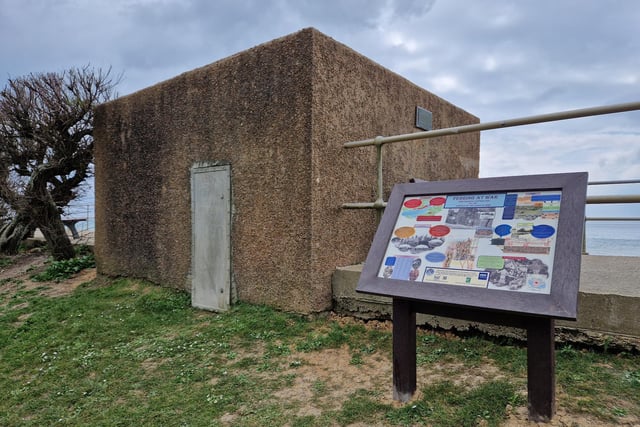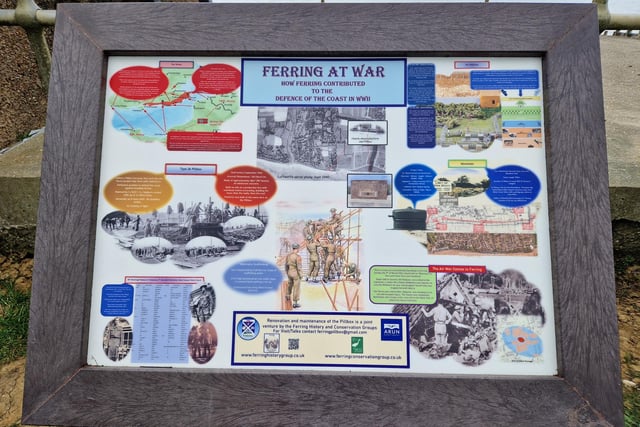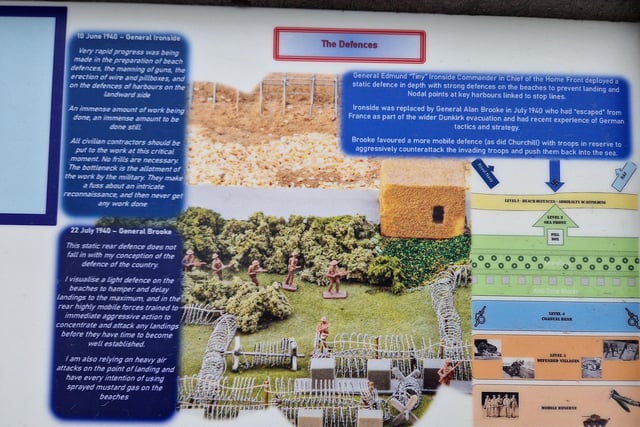Ferring History Group and Ferring Conservation Group have been working together to restore the pillbox, with the help of Ferring Parish Council, ahead of its official opening in May.
Having cleared out the nine inches of water covering the floor of the pillbox, in Patterson’s Walk, volunteers have been working to make the pillbox safe and clean for visitors and school groups.
The new interpretation board, which was recently installed alongside the pillbox, draws together research and artwork covering Second World War coastal defences and explains how Ferring contributed.
General Edmund 'Tiny' Ironside called for strong defences on the beaches to prevent landing by the enemy and rapid progress was made in 1940, including wire on beaches and pillboxes, with 'no frills necessary'.
Although the plaque installed on the pillbox 20 years ago says it was built in 1941, an aerial photo from September 1940, taken by the Luftwaffe, clearly shows the platform and pillbox.
Ferring has a Type 26 pillbox, made of reinforced concrete, and the platform alongside was built at the same time. The pillbox, so called because it looked like the boxes people kept their pills in, would be manned by an NCO and three soldiers, armed with Bren guns. There were no facilities, no heating or light, but shifts would last eight hours.
Four minefields were placed between Sea Lane and the Bluebird Café, with at least 250 mines and 1,600m of barbed wire fencing.
Ironside was replaced by General Alan Brooke in July 1940 and he favoured a more mobile defence, with troops in reserve. The static rear defence, including pillboxes, did not fall in with his concept.
He said, as quoted on the information board: "I visualise a light defence on the beaches to hamper and delay landings to the maximum, and in the rear highly mobile forces trained to immediate aggressive action to concentrate and attack any landings before they have time to become well established."
Hitler had England in his sights and after the swift defeat of northern Europe and France, he issued a Fuhrer Directive on July 16, 1940, to prepare a landing operation on a broad front from Ramsgate in Kent to a point west of the Isle of Wight.
The 10th (Ferring) Platoon of the West Sussex Home Guard was formed in 1940 and the 60 villagers who served are all listed on the information board.
The Ferring pillbox is one of the few remaining examples from a network of defences built all over the British Isles to prevent invasion, and his been identified as a structure of character and historical importance.
There is only one recorded fatal bombing in Ferring. On Sunday, March 9, 1941, a bomb fell on Byeways, in Sea Lane, now Sea Lane Gardens. Gopal Mulkani, 40, and his wife Carmen, 41, were killed in the explosion. A visitor, Mrs Clottie Middleton, was injured and the Mulkani's 16-year-old daughter, Savriti, was trapped beneath debris. Her three-year-old brother Bagwan was sleeping in his cot and escaped injury. The house was completely destroyed and a large crater was left on the west side of where the house had been.

1. Ferring pillbox information board
The story behind a West Sussex pillbox which is one of the best preserved nationally from the Second World War is told on a new information board on Ferring seafront Photo: Elaine Hammond

2. Ferring pillbox information board
The story behind a West Sussex pillbox which is one of the best preserved nationally from the Second World War is told on a new information board on Ferring seafront Photo: Elaine Hammond

3. Ferring pillbox information board
The story behind a West Sussex pillbox which is one of the best preserved nationally from the Second World War is told on a new information board on Ferring seafront Photo: Elaine Hammond

4. Ferring pillbox information board
The story behind a West Sussex pillbox which is one of the best preserved nationally from the Second World War is told on a new information board on Ferring seafront Photo: Elaine Hammond